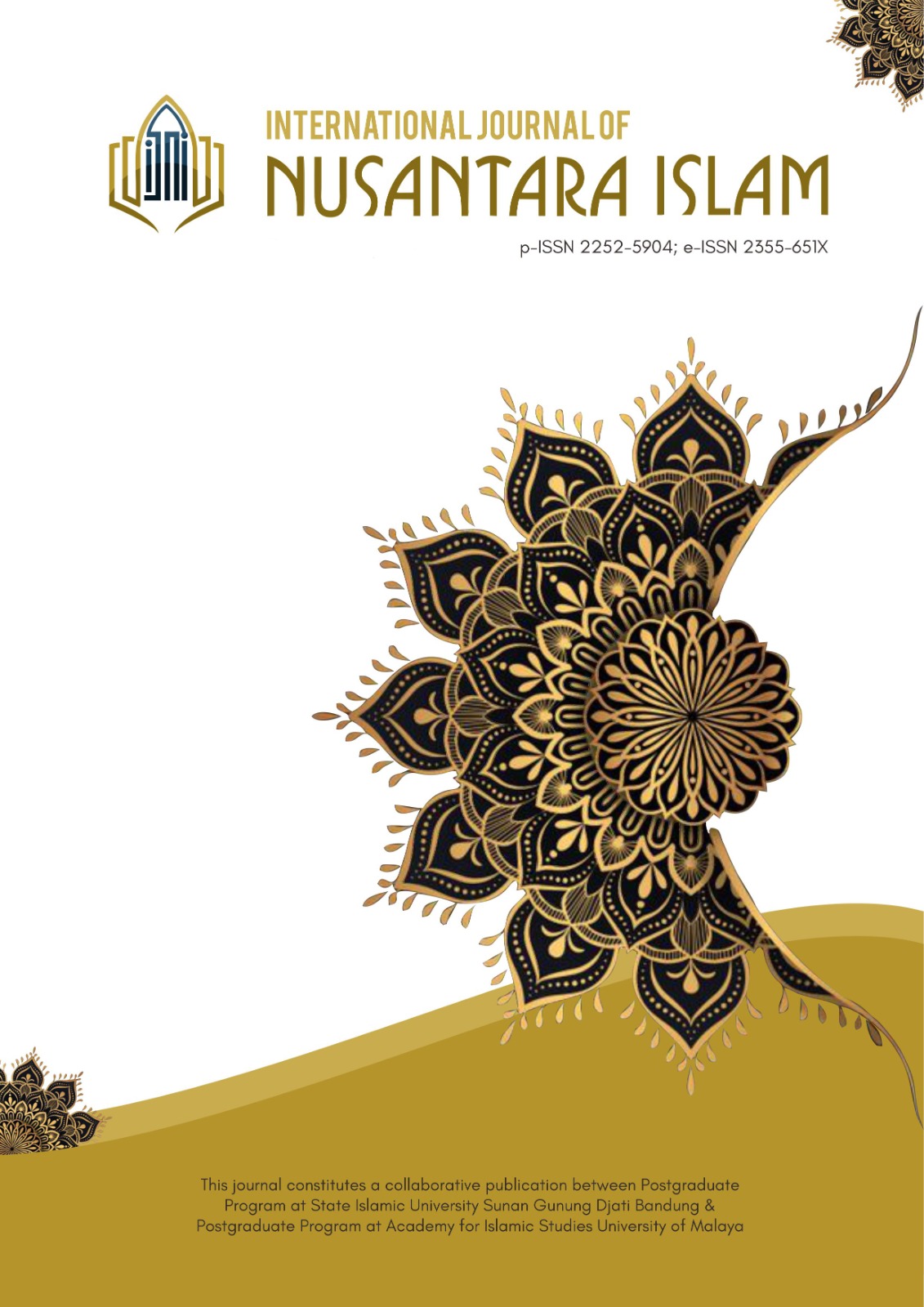Islam and Transgender (A Study of Hadith about Transgender)
Main Article Content
Abstract
One of the issues that have been considered in the public sphere today is the issue of the transgender phenomenon. Transgender is related to the problem of gender identity. It refers to the condition in which the perpetrators identify their identity and gender differently from their sex biologically. It's caused by dissatisfaction and incompatibility between their body and soul. The term transgender might not be so familiar in Indonesia. However, to indicate that phenomenon, some of the people called them "wariaâ€, “priawan†or “tomboy". Generally, their existences were still hard to be accepted because Indonesian people considered this phenomenon as a deviation and it contradicts the moral value and religion in Indonesian society. In the teachings of Islam, the transgender phenomenon has been existed in the early days of the development of Islam, and it has been forbidden strictly. The Islamic view about this issue could be found in the prophet’s hadith explicitly. Hence, to understand this phenomenon, we need to study the hadith. The purpose is as a basis for addressing the transgender phenomenon that was prevalent in Indonesia. The understanding implementation of this hadith, in general, is not easy, because Indonesia is not a country that makes Islam as a formal state system. It has its perspective relate to the transgender phenomenon. Therefore, we have to contextualize this hadith understanding according to the Indonesian context, especially in dealing with transgender perpetrators.
Article Details
The Authors submitting a manuscript do so on the understanding that if accepted for publication, copyright of the article shall be assigned to International Journal of Nusantara Islam, Sunan Gunung Djati State Islamic University.
The copyright encompasses exclusive rights to reproduce and disseminate articles in all forms and media, including reprints, photographs, microfilm, and similar reproductions, as well as translations. Some or all of the contents of this journal can be stored in databases and transmitted in any form and media without the need for written permission from the International Journal of Nusantara Islam, Sunan Gunung Djati State Islamic University.
The Editors and the Advisory International Editorial Board make every effort to ensure that no wrong or misleading data, opinions or statements be published in the journal. In any way, the contents of the articles and advertisements published in the International Journal of Nusantara Islam (IJNI) are sole and exclusive responsibility of their respective authors and advertisers.
References
Abdullah, A. D. (2013). Legal Reasoning Hukum Operasi Ganti Kelamin Penderita Transeksual (Studi Komparasi antara Hukum Islam dan Hukum Perdata). Istinbath: Jurnal Hukum Islam IAIN Mataram, 12(2). Retrieved from https://www.neliti.com/id/publications/41820/legal-reasoning-hukum-operasi-ganti-kelamin-penderita-transeksual-studi-komparas
AbÅ« DÄwÅ«d, S. bin al-Asy’ÄÅ› al-AzdÄ« al-SijistÄnÄ«. (2009a). Sunan AbÄ« DÄwÅ«d (Vol. 6). Beirut: DÄr al-RisÄlah al-’Ālamiyyah.
AbÅ« DÄwÅ«d, S. bin al-Asy’ÄÅ› al-AzdÄ« al-SijistÄnÄ«. (2009b). Sunan AbÄ« DÄwÅ«d (Vol. 7). Beirut: DÄr al-RisÄlah al-’Ālamiyyah.
Al-’AsqalÄnÄ«, A. bin ’AlÄ« bin M. (1993a). Tahżīb al-Tahżīb (Vol. 9). Kairo: DÄr al-KitÄb al-IslÄmÄ«.
Al-’AsqalÄnÄ«, A. bin ’AlÄ« bin M. (1993b). Tahżīb al-Tahżīb (Vol. 4). Kairo: DÄr al-KitÄb al-IslÄmÄ«.
Al-’AsqalÄnÄ«, A. bin ’AlÄ« bin M. (2004). Fath al-BÄrÄ« bi Syarḥ á¹¢aḥīḥ al-BukhÄrÄ« (Vol. 10). Kairo: DÄr al-HadÄ«Å›.
Al-BukhÄrÄ«, M. bin I. (2002). á¹¢aḥīḥ al-BukhÄrÄ«. Beirut: DÄr Ibn Kaśīr.
Gibtiah, G. (2014). Studi Perbandingan tentang Khunsa dengan Transseksual dan Transgender (Telaah Pemikiran Ulama’ Klasik Dan Ulama’ Modern). Intizar, 20(2), 349–362.
Ḥanbal, A. bin M. bin. (n.d.). Musnad Aḥmad bin Ḥanbal (Vol. 4). Beirut: Muassasah al-RisÄlah.
Ibn FÄris, A. al-Ḥusain A. (1979). Mu’jam MaqÄyÄ«s al-Lugah (Vol. 3). Kairo: DÄr al-Fikr.
Jasruddin, J., & Daud, J. (2015). Transgender Dalam Persepsi Masyarakat. EQUILIBRIUM: Jurnal Pendidikan Sosiologi, 3(1). https://doi.org/10.26618/jps-postkrit.v3i1.509
Lestari, I., & Sefitri, S. (2016). Konseling Bagi Populasi Transgender. Jurnal Konseling Gusjigang, 2(1). https://doi.org/10.24176/jkg.v2i1.554
Lestari, Y. S. (2018). Lesbian, Gay, Biseksual, dan Transgender (LGBT) dan Hak Asasi Manusia (HAM). Jurnal Community, 4(1). https://doi.org/10.35308/jcpds.v4i1.193
Masnun, M. (2011). Waria dan Shalat Reinterpretasi Fikih Untuk Kaum Waria. Musãwa Jurnal Studi Gender dan Islam, 10(1), 123–134. https://doi.org/10.14421/musawa.2011.101.123-134
Miskari, M. (2017). Wacana Melegalkan LGBT di Indonesia (Studi Analisis LGBT dalam Perspektif Ham dan Pancasila). Raheema, 3(1). https://doi.org/10.24260/raheema.v3i1.559
Muthmainnah, L. (2018). Problem Eksistensi Transgender di Indonesia Dari Perspektif Politik Komunitarian. Jurnal Filsafat, 24(1), 58–78. https://doi.org/10.22146/jf.34759
Najwah, N. (2007). Tawaran Metode Dalam Studi Living Sunnah. In Metodologi Penelitian Living Qur’an dan Hadis. Yogyakarta: TH-Press.
Najwah, N. (2018). Kriteria Memilih Pasangan Hidup (Kajian Hermeneutika Hadis). Jurnal Studi Ilmu-Ilmu Al-Qur’an Dan Hadis, 17(1), 95–120. https://doi.org/10.14421/qh.2016.1701-05
Papilaya, J. O. (2016). Lesbian, Gay, Biseksual, Transgender (LGBT) dan Keadilan Sosial. PAX HUMANA, 3(1), 025–034.
Pusat Penelitian Kesehatan Universitas Indonesia. (2015). Laporan Kajian Pandangan Transgender Terhadap Status Gender dan Persamaan Hak Asasi Manusia di Jakarta, Bogor, Depok dan Tangerang Tahun 2015. Jakarta: Kemenpppa.
Qomarauzzaman, Q. (2017). Sanksi Pidana Pelaku LGBT dalam Perspektif Fiqh Jinayah. Raheema, 3(1). https://doi.org/10.24260/raheema.v3i1.563
Sodikin, S. (2018). Lesbian, Gay, Bisek dan Transgender (LGBT) Dalam Konsep Hak Asasi Manusia. ’ADALAH, 2(5). https://doi.org/10.15408/adalah.v2i5.8179
Transgender | Definition of Transgender by Lexico. (n.d.). Retrieved 12 October 2019, from Lexico Dictionaries | English website: https://www.lexico.com/en/definition/transgender
Ubaidillah, A., & Rozak, A. (2013). Pendidikan Kewarganegaraan (Civic Education) Pancasila, Demokrasi, HAM, dan Masyarakat Madani. Jakarta: ICCE UIN Syarif Hidayatullah.
Unik, A. (n.d.). Mengenal Sejarah Budaya Waria Dari Berbagai Negara. Retrieved 3 October 2019, from Berita Aneh Unik dan Menarik website: https://www.anehdidunia.com/2017/05/mengenal-sejarah-budaya-waria-dari-berbagai-negara.html
Yayasan Penyelenggara Penterjemah/ Pentafsir Al-Qur’an. (2004). Al-Qur’an dan Terjemahnya Al-JumÄnatul ‘AlÄ«. Bandung: CV Penerbit J-ART.

